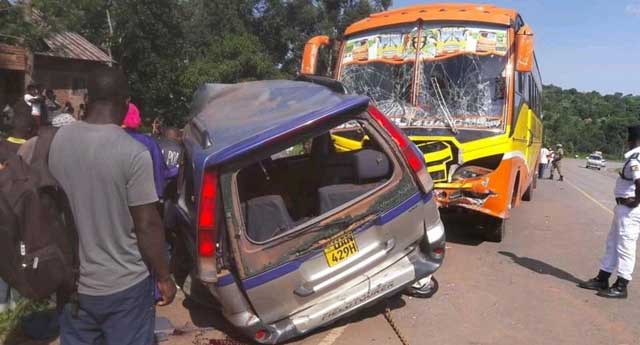
Kampala, Uganda | THE INDEPENDENT | Truck drivers have urged the Uganda police to conduct regular mental tests for drivers in order to reduce road accidents.
At least 3,663 people were killed in road accidents in 2020, according to traffic police. Drivers under their umbrella body, Haulage Trucker Drivers Association [HTDA], say police should not attribute all road accidents to reckless driving but should focus on what is actually forcing people to cause accidents.
Shem Senoga, one of HTDA leaders says as truck drivers, they have identified a number of factors making people to knock pedestrians, motorcyclists, ram into cars or veer off road. Senoga explains that under their body, they have noticed that some people are abusing drugs while others are forced to cause accidents because of very bright lights on cars coming from the opposite direction, narrow roads used by heavy trucks as well as potholes.
HTDA urged the traffic directorate currently headed by CP Lawrence Niwabiine, to look at road designs, mental state of drivers, lights mounted on cars as well as road signs which have been vandalized on major roads.
Traffic director CP Niwabiine says pedestrians and motorcyclists recorded the highest number of victims in 2020 road accidents. Niwabiine explains that pedestrians die most because of the many markets that have mushroomed along highways and mostly in urban areas.
A report by Makerere University College of Health Sciences, School of Public Health highlights the need to put up measures to protect pedestrians who are always the biggest number of victims of road accidents year in year out.
In the study dubbed ‘Road Traffic Injuries and Deaths in Uganda’, Dr. Olive Kobusingye, Prof. David Guwatudde, Dr. Milton Mutto and Prof. Patrick Kyamanywa say pedestrian specific needs must be incorporated in all road works from planning, to design and implementation with attendant supervision and audit.
Since most road accidents and victims are in Kampala city and other urban centres, Dr Kobusingye, Prof. Guwatudde, Dr. Mutto and Prof. Kyamanywa add that most streets need to be rehabilitated in order to reduce accidents.
“There is need for rehabilitation of most streets in Kampala city, and other towns to lane widths of at least 3.50 metres. Urban authorities should consider converting narrow 2-way streets into one-way streets to create wide lanes to accommodate motorcycles, motor vehicles, as well as pedestrian walkways,” the experts highlight in the report.
CP Niwabiine admits that accidents that involve pedestrians usually occur as they try to cross the roads. He adds that in some cases, pedestrians fall victim when vehicles veer off the road and plough into them. Other accidents occur when a driver trying to avoid collision with another vehicle ends up hitting pedestrians.
But Senoga insists that it is time traffic police started focusing on road designs. This is because that some roads are narrow yet they are used by heavy trucks. Senoga adds that potholes force drivers to knock as they try to dodge them.
Police statistics show that 1,258 pedestrians and 1,146 motorcyclists were knocked dead in 2020 respectively. This means four pedestrians and three motorcyclists were killed in road accidents every day.
World Health Organization-WHO report of 2020 acknowledges that road designs can have a considerable impact on safety. WHO, indicates that roads should be designed keeping in mind the safety of all road users.
“This would mean making sure that there are adequate facilities for pedestrians, cyclists, and motorcyclists. Measures such as footpaths, cycling lanes, safe crossing points, and other traffic calming measures can be critical to reducing the risk of injury among these road users,” WHO stated in its February 2020 report on road crashes.
In order to minimize accidents, WHO says effective interventions that should be carried out include designing safer infrastructure and incorporating road safety features into land-use and transport planning, improving the safety features of vehicles, improving post-crash care for victims of road crashes, setting and enforcing laws relating to key risks, and raising public awareness.
*****
URN
 The Independent Uganda: You get the Truth we Pay the Price
The Independent Uganda: You get the Truth we Pay the Price



